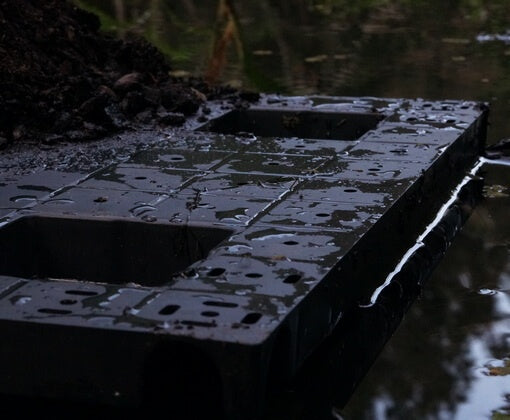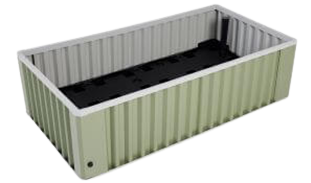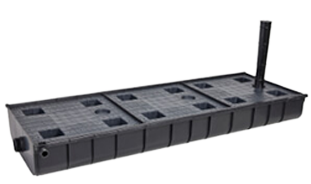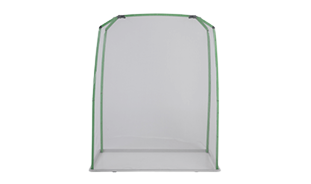How long does the reservoir last in a wicking bed?
As WaterUps are being used by more people in more places we are getting greater understanding of the wicking reservoir water needs in different plant growing situations and how this can vary significantly in a country as vast and diverse as Australia.
Wicking beds operate on the principle of capillary rise or “wicking” from a water reservoir beneath the soil. The method of construction of the water reservoir and its depth determines the water capacity in volume terms in a wicking bed. Old style wicking beds, built on the media displacement principle, using material such a scoria or gravel, hold less water than cell-based reservoir systems such as WaterUps. This is because there is less space for the water to occupy in media displacement wicking beds. Adding more media to increase the water capacity of the reservoir is not a realistic option as this would negatively impact the available growing medium depth.
WaterUps water usage trials
At WaterUps we did a significant amount of field testing of prototypes in 2015 to determine the optimal reservoir depth of 120mm. This was determined after considering factors including the vertical limitations of capillary rise, water capacity and the required soil depth for efficient growing. WaterUps wicking systems hold 120L of water per square metre.
Our first water usage research trial was conducted by scientist and ecologist Peter Rutherford in late 2018. From the results of this trial, and subsequent anecdotal observations over the following summers, we concluded that on average the water reservoir in a WaterUps wicking system would last between 3 and 6 weeks depending on the time of year. With WaterUps now being used widely across Australia, we have been collecting wide ranging feedback from our customers. What we have learnt is that water requirements and reservoir capacity, measured in time before refill, can vary greatly in a country as vast as Australia.
We are often asked the question – “how often do I need to refill my wicking bed”. Based on our experiences in Sydney, we held the view that the reservoir would generally last 3 to 4 weeks in summer and longer in winter. Recently, we were informed of this had certainly not been the case this summer on the outskirts of Adelaide in South Australia.
Mark Smith from Adelaide Hills Vegie Gardens is the WaterUps distributor in South Australia and is also a research scientist. He recently shared with us the following observations.
“I’ve noted for a while this summer that some of my beds used more water than others. I was convinced there had to be a leak somewhere, but none could be found. Instead, what I was observing was growth rates that I had never encountered before. Beds with perennials (rhubarb/asparagus) were draining the reservoir in 2 weeks, a bed with a pear tree is now also joining the party. 9 zucchini plants in a bed measuring 1.2m x 0.8m is lasting only 3 days, but the zucchinis are doubling in size, and I am picking stupid amounts. The tomatoes in my current soil trial with 1 plant per WaterUps® square planter are lasting 7-10 days and they are protected in a greenhouse where the humidity is higher.
We may be one country, but the climate varies so much from state to state. Adelaide is very Mediterranean with hot, dry summers and cool, wet winters. This is very different to Sydney and Melbourne and whilst Perth also has a Mediterranean climate, they get a lot more rain than Adelaide per year. Check out the table.


Wicking beds in Adelaide
Humidity is a big factor in evapotranspiration and the humidity in Adelaide in summer is near zero. It’s bone dry. This results in an increase in evapotranspiration. Adelaide is hotter than Sydney on average. Combining heat, low humidity and virtually no rain results in much higher evapotranspiration, which results in much higher draw of water by plant roots which equals more frequent refilling on the reservoir.The climate in Adelaide is such that we can’t grow vegies successfully in summer without use shade cloth. What all this means is there are a lot of factors which impact of water use, and we haven’t even touched on the type of plant.
When assessing the benefits of wicking beds in an environment like Adelaide instead of focusing on time between refilling, we should be focusing on plant growth rates, plant health and yields. These are vastly superior to the standard garden beds even with the most water efficient irrigation systems. The growth rates I see in my own garden, including the trials I regularly conduct, plus feedback from clients, are higher than anything I have ever encountered.”
This got us thinking about the factors that could influence how long the reservoir will last and we came up with the following. The answer is party situational or climatic, and partly influenced by your growing methodology. Basically, climatic factors such as temperature, humidity, wind and the grower’s approach to things such as plant selection and planting density all come into play. We will look at why these factors are relevant a little later. Before we do it is important to note that there are factors that we can have an influence on and others that are beyond our control.
External factors affecting wicking bed reservoir capacity
The following external factors will affect the reservoir capacity of wicking beds measured in time before needing to refill.
Rainfall
- Wicking beds act as water capture devices unless placed under cover or inside.
Temperature
- High temperature and high humidity will not dry out soil as quickly as high temperature and low humidity, but high temperatures on heat absorbing surfaces will drastically affect the water consumption. Temperature affects the transpiration rate in two ways. Firstly, at warmer temperatures water molecules move faster, and the rate of evaporation from stomata is therefore much faster. Secondly, the water-holding capacity of warm air is greater than that of cold air.
Humidity
- Like humans, plants sweat. In plants it’s called transpiration and when there is less moisture in the air plants will transpire a lot more resulting in faster water usage in a wicking bed. Higher temperatures cause the plant cells, which control the openings (stoma) where water is released to the atmosphere, to open. Colder temperatures cause the openings to close.
- Relative humidity: As the relative humidity of the air surrounding the plant rises, the transpiration rate falls.
Wind
- Much like low humidity, high wind will greatly speed up the plant’s rate of transpiration. Wind can alter rates of transpiration by removing the ‘boundary layer’, the still layer of water vapour hugging the surface of leaves. Wind increases the movement of water from the leaf surface when it reduces the boundary layer, because the path for water to reach the atmosphere is shorter.
Soil water
- The source of water for transpiration out of the plant comes from the soil. Plants with adequate soil moisture will normally transpire at high rates because the soil provides the water to move through the plant. Plants cannot continue to transpire without wilting if the soil is very dry because the water in the xylem that moves out through the leaves is not being replaced by the soil water. This condition causes the leaf to lose turgor or firmness, and the stomata to close. If this loss of turgor continues throughout the plant, the plant will wilt.
Design consideration affecting wicking bed reservoir capacity
If you have a wicking bed, or are designing your own, the following factors will affect the longevity of your water reservoir.
Construction material
- Depending on the materials and colours used in constructing a raised bed, heat may be quickly transferred to soil from the planter material resulting in faster water usage. Dark colours in direct sunlight will cause the soil closest to the container to heat up and quickly evaporate to moisture. This dry soil will then attract water from the moist soil and water will be lost faster than through transpiration alone.
- An insulation layer that traps air, such as corflute, will serve to mitigate this water loss.
Plant selection
- Some plants use more water than others. Tomatoes and Zucchini are particularly thirsty. Water usage will increase as the plants grow and in most cases peak as they approach harvesting time. Fruit is very high in water, as are Asian greens.
- Xerophytes are plants that can tolerate dry conditions due to their CAM physiology, with stomata opening at night, and the presence of several adaptations including reduced and rolled leaves or thick waxy cuticles. Unfortunately, the features that make Xerophytes drought tolerant, also make them unpalatable. Most edible food plants do not have these water saving adaptions.
Planting density
- Wicking systems provide the optimal environment for plant growth, from a watering and soil health perspective. However, due to the constantly available moisture, it is very easy to over plant wicking beds, as they can support much greater plant populations than non-wicking beds. However, more intensive planting will consequently lead to greater water use and potential plant health issues. Not only will the plants struggle to reach maturity, but they will also be exposed to a range of pest and disease issues that will thrive in conditions with poor air movement.
In summary, while climatic factors will be the main determinant of how often you will need to refill the water reservoir in your wicking bed, where you position your bed, plant selection and planting intensity are also relevant.





